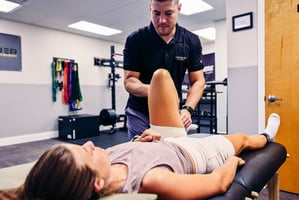Our Physical Therapists are forward-thinking and always seeking ways to enhance our services.
What is Cupping?
Here at Conquer Movement, our performance based Physical Therapists pride themselves on helping you solve for the root cause of your issue. In the initial stages of an injury this may mean getting some modalities involved to help settle down the pain.
Our PTs will often utilize cupping on a regular basis to help keep our athletes and active people feeling and performing their best. Let's dive deeper into the wonderful world of cupping and explore its extensive benefits, particularly how our performance-based Physical Therapists at Conquer Movement utilize this technique to enhance your well-being.
Cupping, with its roots tracing back to ancient Egypt, has evolved into a sophisticated therapy that goes beyond its initial applications. While the distinctive marks left by cupping may catch the eye, the true magic lies in its ability to influence the nervous system. Rather than breaking up adhesions or solely targeting physical symptoms, cupping is a powerful tool for down-regulating the nervous system.

The Nuts and Bolts of Cupping
So, how does it work? Cupping involves creating a vacuum within cups, typically made of glass, plastic, or silicone, that are applied to the skin. The negative pressure generated lifts the skin and underlying tissues, promoting blood flow and encouraging the release of tension. This suction effect can reach deep into the muscles, providing a unique sensation that many find both invigorating and relieving.
Benefits of Cupping
1. Pain Relief
Cupping is renowned for its pain-relieving properties. The suction helps to stimulate blood flow to the targeted area, bringing oxygen and nutrients that aid in the body's natural healing processes. This increased circulation can significantly reduce localized pain and discomfort.
2. Enhanced Range of Motion
By releasing tension and promoting flexibility in the muscles and connective tissues, cupping can lead to improved range of motion. This is particularly beneficial for individuals dealing with stiffness or restricted movement in specific areas of the body.
3. Muscle Recovery
Athletes and active individuals often turn to cupping for muscle recovery. The increased blood circulation helps flush out metabolic waste products, such as lactic acid, from the muscles. This, in turn, accelerates the recovery process, allowing for quicker bounce-back after intense physical activity.
4. Stress Reduction
The calming effect of cupping on the nervous system is not to be underestimated. Many individuals experience reduced stress and anxiety levels following cupping sessions. The therapy promotes relaxation, triggering the body's parasympathetic nervous system response.
Performance-Based Physical Therapy and Cupping
Now, let's explore how our Wilmington based Physical Therapist may strategically incorporate cupping into their treatment approach.
Example 1: Preparing for a Major Competition
Imagine you're an athlete gearing up for a major competition. The anticipation and intense training have taken a toll on your muscles, leading to localized pain and stiffness. This is where cupping comes into play. Our Physical Therapists may use cupping to target specific muscle groups, promoting relaxation and improving blood flow. This not only helps alleviate immediate discomfort but also creates a temporary window of opportunity for enhanced mobility and ease of movement.
Example 2: Managing Chronic Pain
For individuals dealing with chronic pain, cupping can be a valuable tool in a holistic treatment plan. Our Physical Therapists may strategically apply cupping to areas of tension, focusing on down-regulating the nervous system. This approach can contribute to long-term pain management, providing relief without relying solely on traditional methods.
Clarifying the Myth: It's Not About Breaking Up Adhesions
It's essential to debunk a common myth associated with cupping – the notion that it breaks up adhesions. While the suction effect does create space within tissues, it's primarily about influencing the nervous system. Cupping is not a forceful technique aimed at physically breaking down adhesions. Instead, it encourages the body to relax and promotes optimal conditions for natural healing.
"Can I Just Cup Myself?" – The Expert Touch
This is one we get asked all the time – "Can I just cup myself?" While self-application of cups is possible, the true effectiveness of cupping lies in the hands of expert clinicians. Cupping is not a one-size-fits-all approach. It requires a nuanced understanding of anatomy, musculoskeletal issues, and the intricacies of the nervous system.
Consider the story of Henry Ford – when faced with a complex engineering issue due to building of his engines, he turned to an expert who not only fixed the problem but knew precisely where and how to tinker. Similarly, a skilled Physical Therapist knows how to strategically apply cupping to create an optimal environment for your body. Randomly cupping yourself may provide temporary relief, but the true magic lies in the hands of those who understand the art and science of cupping based off of a thorough examination.
Take Aways
Cupping is not just a passing trend; it's a versatile and effective therapy with roots in ancient practices. In the hands of a performance-based Physical Therapist, cupping becomes a strategic tool for promoting pain relief, enhancing range of motion, supporting muscle recovery, and reducing stress which can be a great step in solving the root cause of the issue.
Curious to experience the benefits of cupping for yourself? Schedule your discovery call with our expert Physical Therapists at Conquer Movement. We're here to make your journey friendly, effective, and tailored to your unique needs!





Leave a Comment: